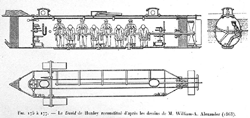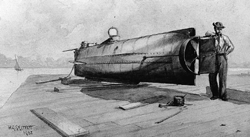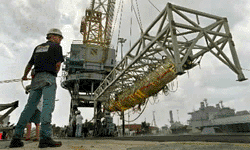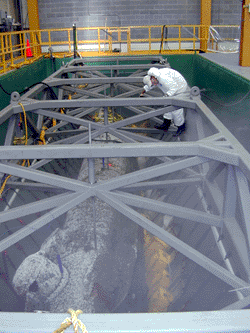 |
53 (3) (2001), pp. 12-14 |
|---|
Feature: Archaeotechnology
 |
53 (3) (2001), pp. 12-14 |
|---|
|
TABLE OF CONTENTS |
|---|
|
|
|
|
|
|
No one knows how it felt to be a Civil War soldier crammed into the submersible iron cylinder called the H.L. Hunley. But Robert Neyland can guess that physical comfort was not a priority. On its final voyage, eight men, seated elbow to elbow, strained to crank a manual propeller, moving the submarine through the currents of South Carolina’s Charleston Harbor. A ninth man stood hunchbacked, steering the vessel. The ceiling was no higher than 1.4 m above the floor, the walls no more than 1.1 m apart (Figure 1). “The walls were probably sweating from condensation,” said Neyland, the U.S. Navy’s chief underwater archaeologist. “If anyone got sea sick, there was no escape.” Neyland hopes to take the guesswork out of the story of the Hunley, its construction, and why it sank in 1864. He is project manager of a diverse team of scientists, archaeologists, and conservators who are using groundbreaking technology to investigate the submarine, which was rescued from the floor of Charleston Harbor in August 2000. The experts are poised to study everything from the rivets of the sub to the DNA of its crew. “It’s a great scientific mystery to solve, applying all the modern techniques of science,” Neyland said.
Author's Notes: See Figure a for an animated illustration of how the H.L. Hunley was retrieved from the floor of Charleston Harbor. Figure b uses time-lapse photography to show the submarine being lifted from the water and placed on a barge, to be transported to a laboratory. To best experience these presentations, you should employ the latest version of RealPlayer.
Encrusted with iron oxide and carbonates in a lumpy, greenish
coating known as concretion, the Hunley after 136 years under water looks
little like an engineering marvel. Yet it is surprisingly hydrodynamic, Neyland
said, with both ends coming to “almost a razor edge” to cut efficiently through
the water. Rivets were sanded, almost flush with the submarine’s exterior, to
reduce friction. “We were expecting something stocky and crude-looking,” Neyland
said. “What we got is something very graceful and sleek-looking” (Figure
2).
The vessel was equipped with two ballast tanks that could be filled with water
to submerge the sub, and pumped to raise it again. “Some of the best engineering
of the south had been applied to the sub,” Neyland said. The vessel was constructed
in 1863 for the Confederate army based on plans of Horace Lawson Hunley, James
R. McClintock, and Baxter Watson. With U.S. Navy ships blockading Charleston
Harbor, the Hunley was planned as a stealth weapon that would approach
the navy ships undetected and ram them with a spar torpedo attached to a long
pole on its bow (For images of the sub, visit the U.S. Navy
website). After planting explosives in the enemy ship, the Hunley
was to back off and detonate them with a rope. That mission was ultimately achieved,
earning the Hunley its place in history as the first submarine to sink
a ship in wartime, but not before the sub sank twice, killing 14 crewmembers
including Horace Lawson Hunley.
The night she sank, on February 17, 1864, the Hunley was on a mission
to torpedo the USS Housatonic, a Federal war ship. For safety’s sake,
the sub was to stay on the water’s surface. It did, and successfully rammed
its spar into the ship’s wooden side, retreated, and detonated 41 kg of explosives.
The Housatonic sank, but the Hunley never returned (For details
on the Hunley's military accomplishments, from a U.S. Navy perspective, see
the Navy
website). Not for another 50 years would a submarine sink another warship,
according to Archaeology,
a publication of the Archaeology
Institute of America.
|
|
 |
|
Figure 1. A cutaway drawing of the Confederate submarine H. L. Hunley. (Image provided by U.S. Navy.) |
 |
|
Figure 2. Early artist’s rendering of the Hunley’s exterior. (Image provided by U.S. Navy.) |
For 131 years the submarine remained undetected, entombed in sand and sediment
6.4 km off the coast of South Carolina’s Sullivan Island. Then, in 1995, author
and adventurer Clive Cussler, with a team from his National
Underwater and Marine Agency, was rewarded for persistence after a 15-year
search. That search was conducted in partnership with the South
Carolina Institute of Anthropology and Archaeology. Dragging a magnetometer
through the water, the explorers located the sub preserved under one meter of
silt, in water 8.5 m deep. The vessel, covered in concretions from 6.4 mm to
19 mm thick, was found intact, lying on its starboard side at a 45-degree angle.
Its cold, dark environment had blocked out oxygen, warding off deterioration
not only of the metal, but also of organic materials, Neyland said. But that
preservation posed a problem: “Once we expose (the sub) to oxygen, the deterioration
rate is going to accelerate,” he said.
Raising the Hunley without damaging it would require years of expensive
preparation. The U.S. Navy became involved,
assigning Neyland, a seasoned archaeologist, to oversee the project. The state
of South Carolina established the Hunley Commission to acquire, recover,
and preserve the sub and its contents. Warren Lasch, a South Carolina businessman,
became chairman of Friends
of the Hunley, a fund-raising arm of the Hunley Commission.
Those groups and others investigated the sub extensively under water and concluded
that, thanks to its sturdy construction, the protective layer of concretion,
and available technology, the Hunley and its contents could be raised
and kept intact.
To bring the sub to the surface, a cradle of 32 nylon belts was developed in
which the vessel would snugly nest. The belts were designed to hang from a bridgelike
truss, providing precisely the same support as existed in the Hunley’s
underwater home. Each belt had a bag attached, which was injected with a quick-setting,
self-sealing foam that was used previously on space shuttle missions, Neyland
said, but adapted for underwater use. As the bag filled, it conformed to the
contours of the submarine.
“In effect, we captured the sub with the same support the seabed was providing
for it,” he said.
The belts were also equipped with load cells to gather data such as load and
strain, determining how tightly each should be pulled to accurately replicate
underwater conditions. In addition, sensors on the belts would continually monitor
oxygen levels.
On August 8, 2000, the system was attached to a crane, and before a cheering
crowd, truss, belts, and sub were moved from the water to the former Charleston
Naval Base, where a special tank had been constructed to contain the relic in
a new laboratory (Figure 3).
The Warren Lasch Conservation Center had been built at the old naval base specifically
for the Hunley. It was equipped with a 16.8 m × 5.5 m × 2.75 m metal
tank filled with chilly water. The water temperature is kept at around 10°C
to reduce the rate of corrosion, said Paul Mardikian, senior conservator for
the project. Mardikian’s job is to protect the integrity of the archaeological
find. “I’m responsible for everything that could go wrong on the project, from
the time it was found under water to the time it is going to be in the museum,”
he said. With this project, plenty can go wrong. Mardikian, whose resume includes
conservation work on wreckage of the Titanic luxury liner and the Confederate
war ship C.S.S. Alabama, said the Hunley is the most challenging
job he has faced, and will set a new standard for maritime archeology.
“From the scientific standpoint…raising, excavating, and conserving the Hunley
is one of the most interesting endeavors of the 21st century,” Mardikian said.
“I think this project would not have been possible 10 or 20 years ago.”
|
|
 |
|
Figure 3. The submarine was carefully secured with nylon straps and foam cushioning, and raised from the floor of Charleston Harbor in August 2000. (Photo provided by Fujifilm.) |
 |
|
Figure 4. A close-up view of the sub’s concretion-covered hatch. A sensor is attached to the hatch’s lower right side, monitoring the conditions of the conservation lab tank. (Photo provided by Fujifilm.) |
A challenge will be to excavate the sub without destroying any artifacts. Because
the oxygen-free environment is likely to have preserved some human remains,
along with a variety of materials such as weapons, tools, navigational instruments,
paper, clothing, and personal items, that mission is especially delicate. For
example, a key to preserving an artifact of any size is neutralizing corrosion.
Normally, when an iron object is under water, that goal can be accomplished
by adding chemicals to maintain a high pH level in the water. Because such chemicals
may be harmful to the human remains inside the sub, Mardikian had to devise
an alternative system to fight corrosion. Maintaining a cold water temperature
was an easy first step, he said. “If you reduce the temperature, you reduce
most of the reactions…bacterial, corrosion rates, enzymatic—everything’s going
to slow down.”
Mardikian further slowed the corrosion rate with cathodic protection, bringing
electrons to the submarine with an impressed current in a system designed by
Corrosion Control Inc., a Georgia firm specializing in cathodic protection and
corrosion control. An iron object losing electrons is similar to a human losing
blood, Mardikian said. By adding electrons, the bleeding is prevented and the
corrosion slows down. “If you turn off the power the corrosion literally jumps,”
Mardikian said.
One of the simplest ways to protect the iron is to protect the concretion coating,
which blocks out oxygen. Fortunately, the Hunley was raised so carefully
that the outside layer was never cracked, Mardikian said (Figure
4). In this controlled environment—the water chemistry in the tank is monitored
continuously for pH, temperature, chlorides, conductivity, oxygen, and corrosion
potential measurements—the sub has been investigated without ever disturbing
its walls or contents.
Using a new three-dimensional (3-D) laser-scanning technique supplied by another
private company, Pacific
Survey Supply, the sub’s exterior has been mapped digitally “down to millimeters,”
Neyland said. “It’s brand new,” he said of the technology. “Most people I’d
known had never seen this before.”
When the time comes to investigate the interior of the sub, the 3-D mapping
will be used again. Neyland has made enough low-tech drawings of ships to appreciate
the 3-D technique.
“I think this is going to have an impact on archaeology,” he said. “I’ve done
these painstaking drawings of ships and shipwrecks. Even if you’re the best
at it you still get a little human error. We would use techniques people have
been using for a hundred years.”
Questions about the sub’s construction will be answered using computed radiography
technology provided by Fujifilm.
That technique, normally used to inspect for structural flaws in equipment such
as jet engines and pipelines, will help determine the details of the Hunley’s
exterior and its contents.
Before the radiography could begin to examine the sub’s contents, though, the
Hunley team had to be assured that the use of x-rays or gamma rays would
not harm the human DNA believed to be on the sub. Degraded human remains were
subjected to high radiation in the lab, and forensic expert Dr. Jamie Dawn checked
the DNA before and after. That testing was recently completed, and because the
Hunley team was convinced no DNA damage would result, excavation began
in early January.
At that time, access to the interior was gained through a hole in the sub’s
stern ballast tank. Using that opening, information can be carefully gathered
about the hull’s construction, Neyland said, such as how the hull plates are
fastened together, and, in turn, how they can be removed. By removing several
of the hull plates, the archaeologists can investigate the interior of the sub
and retrieve its artifacts, according to Neyland (For the most recent update
on the Hunley's excavation, visit the Friends
of the Hunley site).
In case human remains are recovered, the conservation lab is equipped with a
morgue where they can be stored, awaiting forensic analysis and eventual burial.
Other organic materials, such as wood and textiles, will be freeze dried to
prevent decomposition.
With each step carefully calculated to preserve the Hunley
and its contents, the excavation work is not expected to be complete for as
many as ten years. The cost of the project has been estimated at nearly $20
million.
While the investigation continues, Mardikian and his crew will likely be using
techniques such as electrolysis or gaseous reduction to remove iron chlorides
that developed from the iron’s exposure to salt water. When the choride in sodium
chloride binds with iron, the iron becomes unstable and the object is permanently
unstable.
“We’ve got to track them down and remove them,” Mardikian said of the iron chlorides.
When all the work is done, the sub will be moved to a permanent home in the
Charleston Museum, a tribute to the cutting-edge technology of 1863, uncovered
and preserved with the cutting-edge technology of the 21st century.
Maureen Byko is managing editor of JOM.
For more information visit the Friends of the Hunley
web site at www.Hunley.org.
or send e-mail to info@hunley.org.
Direct questions about this or any other JOM page to jom@tms.org.
| If you would like to comment on the March
2001 issue of JOM,
simply complete the JOM on-line critique form |
|||||
|---|---|---|---|---|---|
| Search | TMS Document Center | Subscriptions | Other Hypertext Articles | JOM | TMS OnLine |